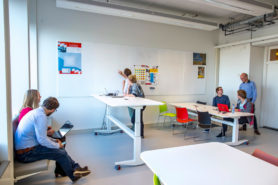Good practices
Reciprocal peer tutoring: letting students learn from each other
 Prof. Dr. Ferdi Engels, lecturer at the Department of Pharmaceutical Sciences, and director of the Undergraduate School of Science at Utrecht University, has tried out a new teaching method in the Teaching & Learning Lab (TLL): Reciprocal peer tutoring. This involves linking pairs of students with different disciplinary backgrounds or experiences and letting them learn from each other. His multidisciplinary bachelor course ‘Meet your brains’ lent itself well to this method.
Prof. Dr. Ferdi Engels, lecturer at the Department of Pharmaceutical Sciences, and director of the Undergraduate School of Science at Utrecht University, has tried out a new teaching method in the Teaching & Learning Lab (TLL): Reciprocal peer tutoring. This involves linking pairs of students with different disciplinary backgrounds or experiences and letting them learn from each other. His multidisciplinary bachelor course ‘Meet your brains’ lent itself well to this method.
About the course
‘Meet your brains’ is the first course in the new (and still in development) minor ‘Brain, mind, and consciousness’. The course is multidisciplinary in both its content and its participants: the brain is approached from various disciplines and angle, and the course is meant for students from all disciplines. Since this was a new course, and it was being offered from Pharmacy, about 95% of the 56 students came from that department, but the hope is that this will change next year – once the course has been promoted more outside Pharmacy. During Block 1, the students met twice a week: once in the TLL and once in a regular lecture room.
Reciprocal peer tutoring
Engels wanted to use the course to try out a new teaching method: reciprocal peer tutoring (RPT). This involves linking pairs of students with different disciplinary backgrounds or experiences. You can for example create a link between a second- and third year student. RPT teaching is set up to let students:
- Learn from each other;
- Complement each other;
- Rely on the other’s help.
An example to illustrate this: If you have a pair of students consisting of a biologist and a psychology student, then for biology topics the biologist will be the ‘tutor’ of the psychologist, with the roles being reversed on psychology topics. The lecturer does not differentiate the material for each discipline, but the students depend on each other for their learning process.
Small-scale teaching method
 Because RPT is a very small-scale teaching method, which demands that the lecturer must be able to observe the lessons well, Engels chose to teach the course (partly) in the TLL. He therefore made intensive use of the flexible set-up of the room, to enable 1-1 and 2-2 interactions between students and observations by the lecturer. He varied the type of furniture, the set-up of the room and the height of the tables. “The flexible set-up and the tool in the TLL are unique, you cannot do this in the regular lecture rooms. But you should not want to do everything in TLL either, because the regular lecture rooms can be used for other things than the TLL,” as Engels says.
Because RPT is a very small-scale teaching method, which demands that the lecturer must be able to observe the lessons well, Engels chose to teach the course (partly) in the TLL. He therefore made intensive use of the flexible set-up of the room, to enable 1-1 and 2-2 interactions between students and observations by the lecturer. He varied the type of furniture, the set-up of the room and the height of the tables. “The flexible set-up and the tool in the TLL are unique, you cannot do this in the regular lecture rooms. But you should not want to do everything in TLL either, because the regular lecture rooms can be used for other things than the TLL,” as Engels says.
Trying things out
Engels is very much interested in the combination of content (what?) and teaching format (how?). He is glad that he can research in his teaching what does or does not work. By teaching in the TLL he kept discovering new things and gaining new ideas: “Might this or that work?” If he is teaching the course again next year, he would definitely want to do it in the TLL again, at least partly, because Engels is not done learning and making discoveries in the TLL.
Just do it!
He would advise other lecturers to make use of the TLL as well, but “lecturers must realise that the TLL is a room to experiment in. Sometimes, your idea will fail. You must also, as a lecturer, think well about what you want to do in this space: What do you want to try out, research, discover? Then you proceed to (re)arrange the room for yourself, which takes time and transpiration (as well as inspiration). Just do it: just reading or hearing about it is not enough, you must have a go and try it. And it would be great if, after discovering and trying out, you make the step to actual research into whether and why a particular approach works.”
Author: Miranda Overbeek (Freudenthal Instituut)

